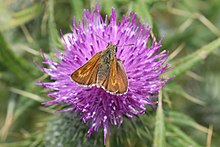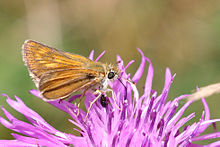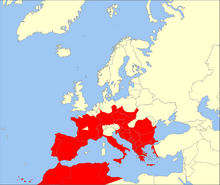Lulworth skipper
| Lulworth skipper | |
|---|---|

| |

| |
| Both females Lulworth Cove, Dorset | |
| Scientific classification | |
| Domain: | Eukaryota |
| Kingdom: | Animalia |
| Phylum: | Arthropoda |
| Class: | Insecta |
| Order: | Lepidoptera |
| Family: | Hesperiidae |
| Genus: | Thymelicus |
| Species: | T. acteon
|
| Binomial name | |
| Thymelicus acteon (
Rottemburg , 1775) | |

| |
| Occurs locally in Asia Minor and North Africa
| |
The Lulworth skipper (Thymelicus acteon) is a
The species occurs locally across
With a wingspan of 24 to 28 millimetres, females being larger than males, the Lulworth skipper is a small butterfly, the smallest member of the genus Thymelicus in Europe and among the smallest butterflies in Britain. Aside from the size difference, the sexes are distinguished by females having a distinct circle of golden marks on each forewing. Due to their likeness to the rays around the eye of a peacock's feather, these are often known as "sun-ray" markings, and they can faintly appear on males.
Taxonomy
The Lulworth skipper was first described by German entomologist S. A. von Rottemburg in 1775.[3] The butterfly was first discovered in Britain on 15 August 1832, when specimens were taken from Lulworth Cove in Dorset by English naturalist James Charles Dale.[3] It was introduced the following year as the Lulworth skipper (Thymelicus acteon), a name that has remained unchanged; it is the only one of Britain's vernacular butterfly names for which there has never been a proposed substitute.[3][4]
Description
The male Lulworth skipper has a wingspan of 24 to 27 millimetres (0.94 to 1.06 in), and the female 25 to 28 mm. This makes it one of Britain's smallest butterflies and, in Europe, the smallest member of the Thymelicus genus.[5] Of Britain's five "golden" skippers—the others being the silver-spotted skipper (Hesperia comma), large skipper (Ochlodes sylvanus), small skipper (Thymelicus sylvestris) and Essex skipper (Thymelicus lineola)—the Lulworth is both the smallest and darkest.[2] Beyond its small size, it is distinguished particularly by its dark, dun-coloured wings that appear with tinges of olive-brown; this darkening especially apparent in males.[6]
Variations are known to occur; in north-west Africa, the uppersides of the forewing and hindwing are darker, with hints of greenish or greyish brown.
The butterfly is sexually dimorphic;[3] females have a distinct circle of golden marks on each forewing, often called "sun-ray" markings due to their likeness to the rays around the eye of a peacock's feather.[6] Males sometimes have these markings, though they are noticeably fainter (see Illustration 1).
-
Illustration 1: Female (left) and Male (right) Lulworth skipper specimens
-
Illustration 2: Tor-grass is the sole food plant of the Lulworth skipper, and plays an important role in its life cycle
-
Illustration from John Curtis's British Entomology Vol. 5
-
underside
Distribution and habitat
The Lulworth skipper is found locally across southern and central
In
Although colonies of Lulworth skippers existed in Devon, the species has, beyond single records, not be seen in the county since the 1930s. Similarly, records of occurrences exist for Cornwall, but they have not been verified as native colonies.[7][12]
Habitats are primarily on unfertilised
Behaviour
Life cycle
The females

Upon hatching, the 2.5 cm (1 in) long
The pupal stage lasts for about two weeks, from the beginning of June onwards, until late July.[14] It is formed inside a loose "nest" of silk and grass that is spun deep inside a tussock of tor grass. Imago begin to emerge in the early middle of July and finish emerging in the middle of September. Typically, they will live for five to ten days—the normal lifespan for a non-hibernating butterfly of the Lulworth's seasonal stage. They fly only in strong sunshine and tend to form discrete colonies,[2] with the largest containing up to 100,000 individuals.[6][12]

See also
Notes and references
Notes
- ^Lulworth skipper adults rarely stray from their favoured breeding areas and are considered poor migrants.[2][6] This is demonstrated by other regions of Britain, containing tor-grass in abundance, where there are no recorded colonies. Any migration to and natural colonisation of Portland would have meant travel across open water, casting further doubt upon the idea. Dispersal must occur, however, as sites such as restored grassland at Durlston and the area between Burton Bradstock and Weymouth have been colonised.[6]
References
- ^ a b c "Lulworth Skipper". Butterfly Conservation. Retrieved 1 July 2009.
- ^ ISBN 978-0-86318-591-5.
- ^ ISBN 978-0-946589-37-1.
- ^ Moss, Stephen (21 July 2009). "My quest for the elusive Lulworth skipper: take two". The Guardian. London. Retrieved 1 January 2010.
- ISBN 978-2-9521620-0-5.
- ^ ISBN 978-0198505655.
- ^ ISBN 978-0-00-219992-6.
- ^ "Thymelicus acteon". Butterfly Conservation Armenia. Retrieved 20 September 2020.
- ^ "UK Priority Species data collation, Thymelicus actaeon" (PDF). Joint Nature Conservation Committee. 15 December 2010. Retrieved 5 April 2013.
- ^ Moss, Stephen (26 August 2008). "On the trail of one of Britain's rarest butterflies". The Guardian. London. Retrieved 1 July 2009.
- ^ McCarthy, Michael (25 July 2009). "A billion painted lady butterflies make for a record summer". The Independent. London. Retrieved 10 August 2009.
Dorset's own butterfly, the tiny Lulworth skipper – found nowhere else in Britain – we trekked up on to the downs above the eponymous Cove
- ^ a b c "Species Action Plan: Lulworth Skipper (Thymelicus acteon)" (PDF). Butterfly Conservation. 1997. Archived from the original (PDF) on 21 June 2010. Retrieved 1 February 2010.
- ^ "Foodplants". UKButterflies. Retrieved 30 June 2009.
- ^ a b c d e "Lulworth Skipper". UK Butterflies. Retrieved 1 July 2009.
External links
- Tree of Life web project Archived 31 December 2018 at the Wayback Machine
- Butterfly Conservation Armenia





